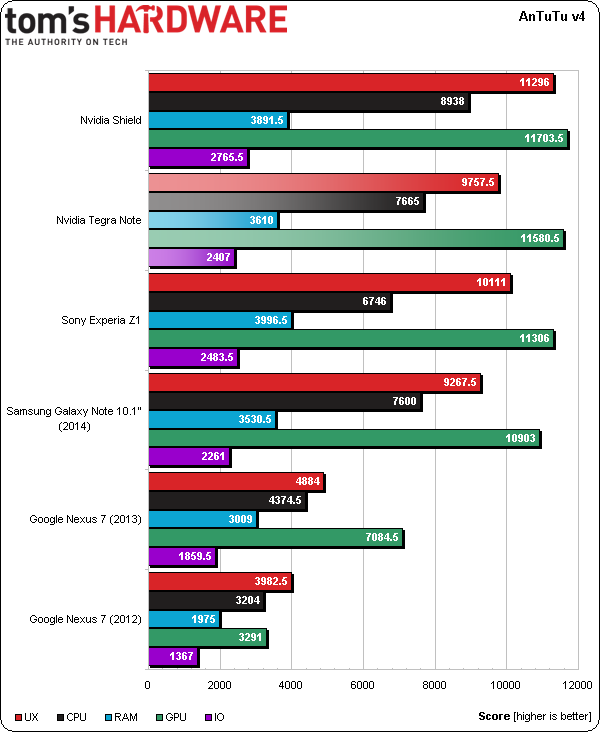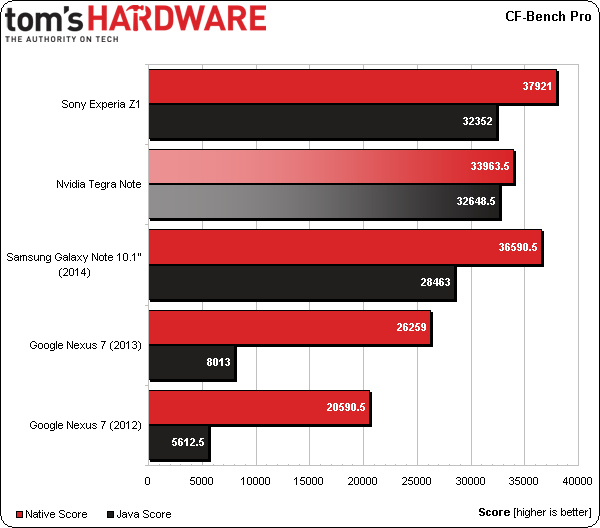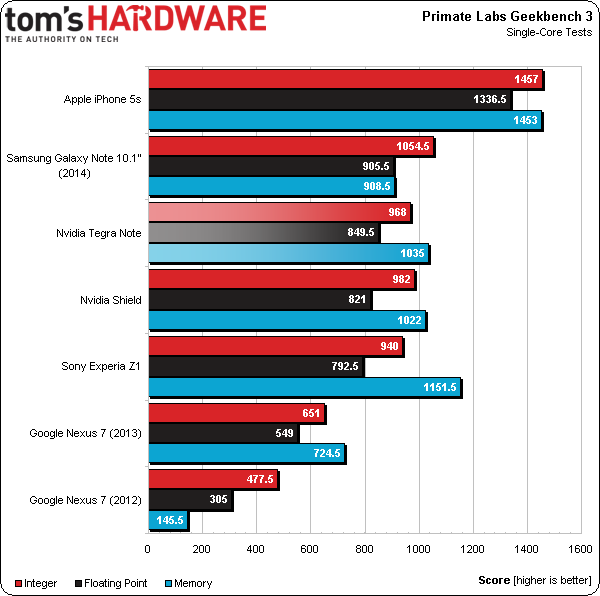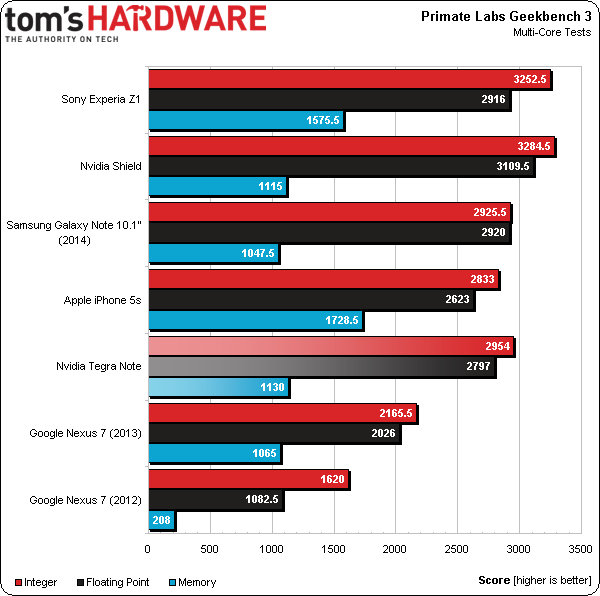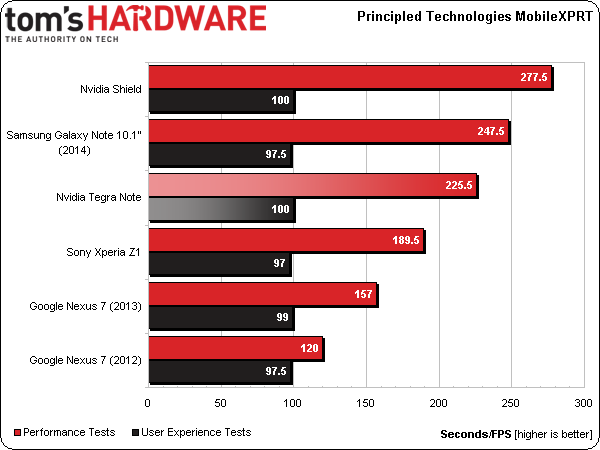EVGA Tegra Note 7 Review: Nvidia's Tegra 4 For $200
Nvidia is partnering with EVGA on the company's second Tegra 4-based device. Its Tegra Note 7 sells for $200, sports unique stylus technology, and ships with a bloatware-free build of Android. Can it set a new standard for affordable seven-inch tablets?
Results: CPU Benchmarks
AnTuTu
AnTuTu is a benchmark designed to test the performance capabilities of four major aspects of mobile devices: Graphics (encompassing 2D, UI and basic 3D), CPU (fixed, floating-point, and threading), RAM (read and write), and I/O (read and write).
Shield comfortably leads in terms of Graphics and CPU performance, which makes sense since it’s up to 100 MHz faster than the Tegra Note and is the only mobile device enjoying active cooling. Tegra Note does come in a very close second, edging out the far more expensive Galaxy Note 10.1, beating it in terms of I/O performance, and finishing almost on par in RAM performance. Tegra Note is priced to compete with Google’s Nexus 7, but manages to keep up and beat out both Sony and Samsung’s flagship devices. Of particular note is the performance of premium devices in terms of RAM throughput: Shield and Xperia Z1 seem to indicate lower latency memory performance, while Samsung’s Note 10.1 does not.
CF-Bench
Chainfire’s (developer of SuperSU, among many other recognised Android tools) CF-Bench Pro is designed to characterize the performance of multi-core systems by simulating loads in Java both in terms of natively compiled and managed code. It tends to be a decent indicator of the tweaks vendors make to Android to eke out extra performance when they optimise with specific hardware features in mind. Nvidia’s Shield wouldn’t run this benchmark, and is thus absent.
Sony has been optimising for Snapdragon-based devices since the Xperia range took on the Krait core, and its experience shows as the Xperia Z1 comfortably leads the Tegra Note and Galaxy Note 10.1 in both Managed and Native. Still, Nvidia’s Tegra Note 7 easily takes second place overall, despite being slower in terms of native performance than Samsung’s Exynos 5-based 10” tablet. Critically, Exynos seems to have to a lot of raw performance, as demonstrated by its substantial Native Code score. But Samsung doesn’t seem to be optimising at the Java side as much. Tegra Note, again, performs extremely well considering it’s priced to compete with Google’s Nexus 7.
Geekbench
Primate Labs’ Geekbench is somewhat of an industry standard due to its comprehensive database and cross-platform compatibility, supporting x86 Windows, PPC and x86 Apple OS X, iOS, and Android. While Geekbench is more of CPU performance benchmark, it also covers some general memory performance, too. Geekbench’s approach is based on real-world applications and simulations of regularly used tasks (file/data manipulation, compression, encryption, and image processing).
When we isolate single-core performance, Apple’s iPhone 5s sweeps ahead with a substantial lead in every category, which may indicate that Geekbench favors Apple’s A7 ARMv8 64-bit double-wide register approach. Comparing Android devices, it seems that the Exynos 5-powered Galaxy Note 10.1 has considerably more grunt than either Tegra 4 or Snapdragon 800, but it’s necessary to weigh this data critically in light of recent revelations. Tegra Note runs almost neck and neck with Shield, taking the lead in memory throughput and floating-point math, but losing in the integer testing. Tegra Note once again proves to be an extremely good value for you spend on it.
In multi-core testing, the finishing order gets reshuffled quite extensively. Sony’s SD800-based Xperia Z1 takes a reasonable lead, proving that Apple’s reliance on ARMv8’s 64-bit double-wide registers isn’t the whole story. The use case for single-core in mobile computing is continually shrinking, and these results may be more indicative of real-world performance. Shield's active cooling might help explain the complete turnabout from the previous single-core results, as more resources remain available due to less heat. Tegra Note, which was ahead of Shield in single-core performance, now sits well behind by at least a 10%.
Get Tom's Hardware's best news and in-depth reviews, straight to your inbox.
MobileXPRT
Principled Technologies’ MobileXPRT is not dissimilar to certain aspects of Geekbench in that it simulates real world applications and use cases. Where it differs is twofold: first, it’s Android-only, and second, it simulates some more modern aspects that Geekbench doesn’t, namely Biometrics (Facial Recognition), UX (List Scroll, Grid Scroll, Gallery Scroll, Browser Scroll, and Zoom and Pinch to Zoom), and Photo Management (Apply Photo Effects, Create Photo Collages, Create Slideshow and Organize Photos).
Anyone who has used Shield will tell you that it yields a very smooth experience, and that’s likely attributable to specific software optimisations implemented by Nvidia (such optimisations also might indicate why CF-Bench would not run at all on the device). The platform is in full effect here; Shield blows this test away in the performance tests and maxes out the User Experience suite. Tegra Note’s theoretical clock rate deficit might be reflected in the slower Performance Tests result, but could indicate fewer optimisations or tweaks applied to the Tegra Note (which, again, would go some way to explaining why it could run CF-Bench, while Shield could not).
Current page: Results: CPU Benchmarks
Prev Page Test Setup And Methodology Next Page Results: GPU Benchmarks-
DelightfulDucklings Performance wise it is very good for the price seemingly but I just hate the design, to me it just looks plain uglyReply -
JD88 Front facing speakers are really nice. One of the very few complaints I have about my Nexus 7 is volume.Reply
This thing is a powerhouse for the money. -
ananke No 1080p, no sales. Otherwise great device, and good price, but DOA because of the screen. The Chinese knock offs will outsell it.Reply -
TheSchmed I am considering buying this tablet, but I'm weighing it against the less-expensive Dell Venue 7 and 8 (Android, not W8). I hope Tom's will review the Dell tablets and evaluate Intel processor performance and battery life!Reply -
somebodyspecial CF BENCH:Reply
"Sony has been optimising for Snapdragon-based devices since the Xperia range took on the Krait core, and its experience shows as the Xperia Z1 comfortably leads the Tegra Note and Galaxy Note 10.1 in both Managed and Native."
xperia java=32352
Tegra Note7=32648.5
Unless I'm not understanding what is going on here, 32648 is the longer bar/better score right? So while it lost NATIVE, it did not lose Java Managed right? It seems Sony won NATIVE and TEGRA note 7 won Java Managed. You need to fix the text. -
Lessthannil Why does everyone complain about no 1080p? The difference between 1280x800 to 1920X1080p on a 7" screen is minimal while it requires signifigantly more performance and power. Also, its a $199 tablet, what where you expecting?Reply -
JeanLuc While benchmarking did you check to see if the any of the devices you were testing were boosting the SOC clock rates beyond the advertised clock speeds in certain benchmarks? Anandtech looked at this issue a while ago, it would be good to see publications like Toms testing for this sorting of thing and name and shame culprits.Reply -
somebodyspecial Shows the power of the T4, I just wish they'd put it in something I want. And I agree 1080p min on anything that is above a phone' 5in size. But I also understand some just don't care so really a personally complaint about that. I'll wait for T5 and hope they get it into 1080/1200p on 13in or 20in ;) I have no use for 10 or below after using nexus10. Print etc, stuff is just too dang small. Maybe spoiled by 24in/22in dual monitors. I just can do squat on something that small and enjoy it other than some games and I'm not even sure about that. I hope they make a 7in shield 2 :) (maybe a 10in?...LOL).Reply
Smaller and THINNER (you took how much of my batter for thinner?) are USELESS to me. Give me back that larger and FAT model please, so I can run with more power or longer life (or some combo of both). As soon as I see "THINNER" in any description I just put my wallet back and shake my head :( Did I want thinner 10-15 years ago, yeah...Now that party ended ages ago for me.
